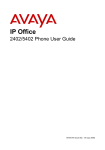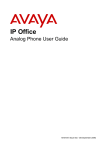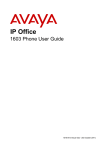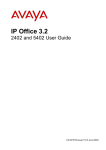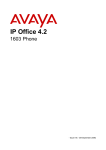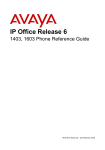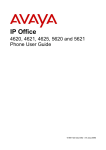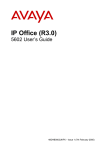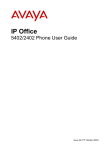Download IP Office 4602/5602 Phone User Guide
Transcript
IP Office 4602/5602 Phone User Guide 15-601076 Issue 05a - (16 July 2009) © 2009 AVAYA All Rights Reserved. Notice While reasonable efforts were made to ensure that the information in this document was complete and accurate at the time of printing, Avaya Inc. can assume no liability for any errors. Changes and corrections to the information in this document may be incorporated in future releases. Documentation Disclaimer Avaya Inc. is not responsible for any modifications, additions, or deletions to the original published version of this documentation unless such modifications, additions, or deletions were performed by Avaya. Link Disclaimer Avaya Inc. is not responsible for the contents or reliability of any linked Web sites referenced elsewhere within this Documentation, and Avaya does not necessarily endorse the products, services, or information described or offered within them. We cannot guarantee that these links will work all of the time and we have no control over the availability of the linked pages. License USE OR INSTALLATION OF THE PRODUCT INDICATES THE END USER’S ACCEPTANCE OF THE TERMS SET FORTH HEREIN AND THE GENERAL LICENSE TERMS AVAILABLE ON THE AVAYA WEBSITE AT http://support.avaya.com/LicenseInfo/ (“GENERAL LICENSE TERMS”). IF YOU DO NOT WISH TO BE BOUND BY THESE TERMS, YOU MUST RETURN THE PRODUCT(S) TO THE POINT OF PURCHASE WITHIN TEN (10) DAYS OF DELIVERY FOR A REFUND OR CREDIT. Avaya grants End User a license within the scope of the license types described below. The applicable number of licenses and units of capacity for which the license is granted will be one (1), unless a different number of licenses or units of capacity is specified in the Documentation or other materials available to End User. “Designated Processor” means a single stand-alone computing device. “Server” means a Designated Processor that hosts a software application to be accessed by multiple users. “Software” means the computer programs in object code, originally licensed by Avaya and ultimately utilized by End User, whether as stand-alone Products or pre-installed on Hardware. “Hardware” means the standard hardware Products, originally sold by Avaya and ultimately utilized by End User. License Type(s): Designated System(s) License (DS). End User may install and use each copy of the Software on only one Designated Processor, unless a different number of Designated Processors is indicated in the Documentation or other materials available to End User. Avaya may require the Designated Processor(s) to be identified by type, serial number, feature key, location or other specific designation, or to be provided by End User to Avaya through electronic means established by Avaya specifically for this purpose. Copyright Except where expressly stated otherwise, the Product is protected by copyright and other laws respecting proprietary rights. Unauthorized reproduction, transfer, and or use can be a criminal, as well as a civil, offense under the applicable law. Third-Party Components Certain software programs or portions thereof included in the Product may contain software distributed under third party agreements (“Third Party Components”), which may contain terms that expand or limit rights to use certain portions of the Product (“Third Party Terms”). Information identifying Third Party Components and the Third Party Terms that apply to them is available on Avaya’s web site at: http://support.avaya.com/ThirdPartyLicense/ Avaya Fraud Intervention If you suspect that you are being victimized by toll fraud and you need technical assistance or support, call Technical Service Center Toll Fraud Intervention Hotline at +1-800-643-2353 for the United States and Canada. Suspected security vulnerabilities with Avaya Products should be reported to Avaya by sending mail to: securityalerts@avaya.com. For additional support telephone numbers, see the Avaya Support web site (http://www.avaya.com/support). Trademarks Avaya and the Avaya logo are registered trademarks of Avaya Inc. in the United States of America and other jurisdictions. Unless otherwise provided in this document, marks identified by “®,” “™” and “SM” are registered marks, trademarks and service marks, respectively, of Avaya Inc. All other trademarks are the property of their respective owners. Documentation information For the most current versions of documentation, go to the Avaya Support web site (http://www.avaya.com/support) or the IP Office Knowledge Base (http://marketingtools.avaya.com/knowledgebase/). Avaya Support Avaya provides a telephone number for you to use to report problems or to ask questions about your contact center. The support telephone number is 1 800 628 2888 in the United States. For additional support telephone numbers, see the Avaya Web site: http://www.avaya.com/support. 4602/5602 Phone IP Office Page 2 15-601076 Issue 05a (16 July 2009) Contents Contents 1. The Telephone 1.1 Call Appearance ..................................................................... Keys 8 1.2 Logging On ..................................................................... 9 1.3 Logging Off ..................................................................... 9 1.4 No User ..................................................................... 10 1.5 The Display..................................................................... 10 ..................................................................... 10 1.6 Personalized Ring 2. Call Handling 2.1 Answering ..................................................................... a Call 2.2 Making a Call ..................................................................... 2.3 Clearing a ..................................................................... Call 2.4 Redial ..................................................................... 2.5 Speaker ..................................................................... 2.6 Mute ..................................................................... 2.7 Hold ..................................................................... 2.8 Transfer ..................................................................... 2.9 Conference..................................................................... 2.10 Message ..................................................................... 12 13 13 13 13 14 14 15 15 15 3. System Features 3.1 Introduction..................................................................... 18 ..................................................................... 18 3.2 Call Forwarding 3.3 Diverting Calls ..................................................................... 19 3.4 Do Not Disturb ..................................................................... 19 3.5 Parking Calls ..................................................................... 20 3.6 Private Call..................................................................... 21 3.7 Voicemail ..................................................................... 21 3.8 Default Feature Codes ..................................................................... 22 Index ...............................................................................23 4602/5602 Phone IP Office Page 3 15-601076 Issue 05a (16 July 2009) Chapter 1. The Telephone 4602/5602 Phone IP Office Page 5 15-601076 Issue 05a (16 July 2009) The Telephone: 1. The Telephone This guide covers the use of the 4602 and 5602 phones on the IP Office phone system. Both phones are similar, however the 5602 is only supported on the IP Office whereas the 4602 is supported on a range of Avaya phone systems. 1. Display, Call Appearance: Two Call Appearance Keys allow you to handle multiple calls. The display shows call information. 2. Message Lamp: This lamp is used as follows; · 3. 4. MESSAGES: Access your voicemail mailbox. Call Handling Buttons: · · · · · 5. 6. On (Continuous): There are new messages in your voicemail mailbox, or in another mailbox for which you have been configured to receive "Message Waiting Indication". HOLD: Red button used to place a call on hold. TRANSFER: Transfers a call to another phone. CONFERENCE: Sets up conference calls with more than one other person. DROP: Drops the current call or, if on a conference call, drops the last person to join the conference. REDIAL: Redials the last number dialed or displays the last 6 numbers dialed from the phone, depending on configuration via the Options menu. Dial Pad: Standard 12-button pad for dialling phone numbers. Volume Controls: Adjusts the speaker ringer volume depending on which is currently in use. 7. MUTE: Turns the handset microphone on/off. When muted, the associated light is on and the caller cannot hear you. 8. Feature: The system administrator can configure a number of special features which are then accessed by pressing this key followed by any of the keys; 0 to 9, * or #. 9. SPEAKER: Pressing this key transfers the current call to the phone’s speaker. The adjacent lamp is lit when the speaker is in use. Note however that the phone has no microphone and the handset is muted when the speaker is being used, ie. This is a listen only mode. This button can be used to answer calls and to end calls being listened to on the speaker. 4602/5602 Phone IP Office Page 7 15-601076 Issue 05a (16 July 2009) 1.1 Call Appearance Keys Normally, the call handling screen contains two keys set as 'call appearance' keys. Having more than one call appearance key is useful. When holding a call you can answer another call and then use the call appearance keys to switch between calls. Having two Call Appearance keys is very useful. When holding a call you can answer/make another call and then switch between calls or transfer or conference. If you are set to receive call waiting indication, the waiting call is shown against the next call appearance key. Call Appearance Key Icons The icons displayed against the Call Appearance Keys allow you to determine the status (for example, on HOLD) of each call. Icons also indicate whether a feature has been activated for a particular button. Incoming Call: A symbol next to a call appearance key indicates an incoming call. To answer the call and put any other current call on hold, press / . Connected: A symbol next to a call appearance key indicates that it is the currently connected call. The caller's phone number (if available) is also shown. On HOLD: · To put the call on hold, press · To take the call off hold, press 4602/5602 Phone IP Office HOLD or the adjacent . indicates a call on hold and an H is displayed. HOLD. Page 8 15-601076 Issue 05a (16 July 2009) The Telephone: Call Appearance Keys 1.2 Logging On Your administrator has created your initial configuration so that you will be automatically logged on to your home extension. However, you may be required to log in for the following reasons: · Forced login - if your configuration does not allow automatic login to your home extension. · To use an extension other than your own (hot desking) · If you, or somebody else, has logged you out of your extension. Note · When hot desking, any short codes you have setup on your home extension will be passed to the extension you have logged on to. · Certain information such as speed-dials and call log are telephone model dependent, and will not be passed to the new extension. · You will be able to hot desk to extensions on remote sites only if the Small Community Advanced Networking License is installed on that system. To login to your home extension (forced login), enter *35*P#, where 'P' is your login code. To login at another extension (hot desking), enter *35*N*P#, where 'N' is your home extension number and 'P' is your login code. Note · Your login code, if configured, will be supplied by your Administrator. · You have 4 attempts at logging on. If you fail to logon correctly, the message "Invalid" will be shown on the main display and you will hear the busy tone. If you fail all 4 attempts to log on, you must wait 90 seconds before any login will be accepted, whether correct or not. 1.3 Logging Off If you have been allocated a login code, you can log your phone off to prevent unauthorized use during an absence, or for privacy purposes. If you are logging off from another extension, the system will log you back in at your home extension, unless the forcelogin option is set. Caution · Call Log entries and certain Speed Dial settings will remain on the extension even once you are logged out. To log off the phone where you had logged on dial *36. 4602/5602 Phone IP Office Page 9 15-601076 Issue 05a (16 July 2009) 1.4 No User The NoUser configuration will be used for extensions where the home user is not currently logged on for example: · The home user is logged on to another extension · Forced login is enabled An extension set as NoUser will display the name "NoUser" and the extension number line will be blank or not-available. If required, and you have been allocated a login code, you can logon using your extension number and login code. (see Logging On 9 ) Note · Although calls may be made from an extension marked NoUser, calls cannot be received on that extension. 1.5 The Display B Phone Locked: Internal calls only. D Call Forwarding On: See Call Forwarding 18 . G In Group: You can enable/disable group membership. H Held Call: Shows the number of held calls. See HOLD 14 . N Do Not Disturb On: See Do Not Disturb 19 . O Out of Hours: This is displayed if one or more Hunt Groups is in "Out-of-Hours" mode. P Parked Calls: Shows the number of parked calls. T Twinned: The phone is being used as the twin of another phone. DISC Disconnected: To end the call, press SPEAKER. CONN Connected: You are on a call. CONF CONFERENCE Call: You are part of a conference call, displayed on the left hand side of the display. See CONFERENCE Calls 15 . 1.6 Personalized Ring You can select one of 8 ring sounds for the phone. To do this, when the phone is idle, press the button. The phone will ring. Press the button again until you hear the sound you want to use. 4602/5602 Phone IP Office CONFERENCE Page 10 15-601076 Issue 05a (16 July 2009) Chapter 2. Call Handling 4602/5602 Phone IP Office Page 11 15-601076 Issue 05a (16 July 2009) 2. Call Handling 2.1 Answering a Call When a call arrives at your phone, you hear a ringing tone and a flashing bell icon ( ) appears on the associated call appearance display. The following describes how to use your handset to answer calls. To answer an incoming call: Do one of the following: · If you are not active on another call, answer the call by lifting your handset. You can also press caller. SPEAKER to listen to the incoming call, but you must use the handset to speak to the or · If you are active on a call already, place the active call on ). HOLD and then answer the incoming call (see Hold 14 To answer a call at another extension: You can answer from your own phone by using Call Pick-Up; lift your handset and dial: · *30 to answer a call ringing anywhere. · *31 to answer a call within your group. · *32*201# to answer the call for a particular extension, in this example 201. The default ringing cadences are: · Internal calls - single ring cadence. · External calls - double ring cadence. These can be changed by your system administrator. Note · If your phone rings for any longer than a specified period (15 seconds in default), any re-direction feature that you have activated, such as voicemail or call forwarding, will come into effect. 4602/5602 Phone IP Office Page 12 15-601076 Issue 05a (16 July 2009) Call Handling: Answering a Call 2.2 Making a Call You can make calls from the phone using a variety of methods as follows: To manually make a call: 1. Dial the required number on the key pad (remember to include the required access code (for example, 9) for an outside line) and listen to the progress of the call. 2. Adjust the speaker volume as necessary. To change the volume, press displayed. 3. If the call is not answered, press SPEAKER or to clear the call, press and . Eight volume levels are DROP. or When the call is answered, you must pick up the handset to speak to the called party. To automatically make a call: · To have the phone dial the last number that you dialed, press REDIAL and . 2.3 Clearing a Call To clear an established call: Do one of the following: · Replace the handset. · Press DROP. You will hear dial tone, unless you are in ‘call centre mode’ (where the line is silent). 2.4 Redial The REDIAL feature automatically redials the last extension or outside number (up to 24 digits) you dialed. To redial the last number that you dialed: · Press REDIAL. 2.5 Speaker Pressing this key transfers the current call to the phone’s speaker. The adjacent lamp is lit when the speaker is in use. Note however that the phone has no microphone and the handset is muted when the speaker is being used, ie. This is a listen only mode. This button can be used to answer calls and to end calls being listened to on the speaker. 4602/5602 Phone IP Office Page 13 15-601076 Issue 05a (16 July 2009) 2.6 Mute With a call in progress, you can stop the other party from hearing you. To switch off your handset microphone: MUTE. The lamp beside Mute comes on. · Press · To re-instate the 2-way conversation, press MUTE again. 2.7 Hold If, with a call in progress, a second call arrives and is shown against a Call Appearance key, you can hold the first call and answer the second call. To put an existing call on hold: 1. Press HOLD or or with against it. The symbol changes to 2. Answer the second call by pressing the Call Appearance button with that the line is connected. ; showing that the line is on hold. against it. The symbol changes to ; showing To return to the held call: 1. If you have a call in progress, then first put that call on hold as above. 2. To retrieve a held call, press the Call Appearance button with against it. Notes · After a pre-set time (defined by your system administrator), you are reminded that you have a call on hold by changing for a few moments to and the phone ringing. · If the system feature AutoHold is on (consult your system administrator) then you can hold an active call ( ) by pressing the second call’s ( ). If AutoHold is off, then pressing the second call’s ( ) will drop the first call. · To transfer a held call, see Transfer 4602/5602 Phone IP Office 15 . Page 14 15-601076 Issue 05a (16 July 2009) Call Handling: Hold 2.8 Transfer This feature allows you to transfer a call from your phone to another extension or outside number. 1. With a call in progress, press TRANSFER. 2. When you hear dial tone, dial the number to which the call is to be transferred. Then do one of the following: · To transfer the call without announcing it (an unsupervised transfer), press transfer is complete. TRANSFER again. The · To announce the call before transferring it (a supervised transfer), wait for the called party to answer: · If the called party is willing to accept the call, press TRANSFER again to complete the transfer. · If the called party does not wish to accept the call or there is no answer, press the held call, press adjacent to it. DROP. To return to 2.9 Conference The Conference feature allows you to conference other parties (including yourself) into a call. To add another party to a call: 1. Press 2. Dial the number of the person you want to add to the call. If the called party does not answer or does not want to join the conference, press held call by pressing its call appearance button. CONFERENCE. 3. To add the person to the call, press 4. Repeat steps 1 through 3 for additional conference connections. DROP. You can return to the CONFERENCE again. To add a held call to an active call: · Press · The number of parties allowed in a conference is controlled by your phone system. · To remove yourself from the conference, hang up. CONFERENCE. All held calls are added to the conference. 2.10 Message MESSAGES is used to access the voicemail system if installed. Once pressed, the prompts given will depend on the type of voicemail system. For further details refer to the Mailbox User Guides provided for the different voicemail systems supported by IP Office. The message lamp at the top of the phone stays lit when there are new messages in your voicemail mailbox, or in any other mailbox, for which you have been configured to receive "Message Waiting Indication". 4602/5602 Phone IP Office Page 15 15-601076 Issue 05a (16 July 2009) Chapter 3. System Features 4602/5602 Phone IP Office Page 17 15-601076 Issue 05a (16 July 2009) 3. System Features 3.1 Introduction As well as your phones' specific features, you can access a number of system features by dialling short codes. These instructions are for the system's default configuration. They assume that you are using the default feature codes. It also assumes that you have full access to all features and the public phone network. 3.2 Call Forwarding Your calls can be forwarded to another extension or an external number when: · You are away from your desk (on no answer). · Your extension is busy (on all Call Appearance keys). · You are away from the office (e.g. when you are on holiday). Note You must set the to which your calls will be forwarded to before using the other features. The following options are available for call forwarding: · To set the number to which your calls are forwarded, dial *07*201# (forwarding to 201 in this example). · To switch Forward Unconditional On (i.e. not Hunt Group), dial *01. A D is displayed. To switch it off, dial *02. · To switch Forward On Busy On, dial *03. To switch it off, dial *04. · To switch Forward On No Answer On, dial *05. To switch it off, dial *06. · To switch Forward Hunt Group Calls On, dial *50. To switch it off, dial *51. This setting is for Forward Unconditional On only. · To Cancel All Forwarding, dial *00. Notes · Cancelling all forwarding will also cancel any Follow Me you have set. · To change the number you wish to forward your calls to, simply set the number with the new extension. 4602/5602 Phone IP Office Page 18 15-601076 Issue 05a (16 July 2009) System Features: Call Forwarding 3.3 Diverting Calls You can divert your calls to another extension using Follow Me. Unlike Forward, Follow me can only be used to divert calls to another internal extension on the same IP Office. Note · If you do not answer calls at the temporary extension, they are forwarded to your own voicemail or call forwarding number. To use Follow-Me-Here from another extension: In this case, N is your home extension · Dial *12*N# from the extension you are temporarily using. · Dial *13*N# to re-direct the calls back to your own extension, before you return to it. To use Follow-Me-To from your own extension: In this case, N is the extension to which you want your calls diverted. · Dial *14*N# from your own extension. · Dial *14*# to cancel either feature from your own extension. Notes · If you use the option[****] · Follow Me does not apply to the following call types: 18 Cancel All Forwarding 18 , your Follow Me will also be cancelled. — Voicemail Callback — Automatic Call Back — Hold or Park return. 3.4 Do Not Disturb You may choose to receive no calls at all or only those from particular callers on your exceptions list: · To switch Do Not Disturb on (with or without exceptions), dial *08. An N is displayed. To switch it off, dial *09. · To add a number to the exception list, dial *10*N#. · To delete a number from the exception list, dial *11*N#. Note · Your callers, other than your exceptions, either hear busy tone or are re-directed to your voicemail. · The only call that will ignore the Do Not Disturb rule will be one where you were the original caller, then performed an unsupervised transfer to another extension. If that extension does not answer, the call will be re-directed to you as the originator. 4602/5602 Phone IP Office Page 19 15-601076 Issue 05a (16 July 2009) 3.5 Parking Calls You can park one or up to ten calls; allowing you to make and receive other calls. You can also arrange for the parked call to be retrieved by another extension. Note The system only allows calls to be parked for a short while before reconnecting them; the default setting is 5 minutes. Once the set time is reached, the parked call will ring back, or if your extension is busy, will ring back when your extension is free. When you park a call, it is given a slot id number based on your extension number followed by 0. If you park another call, it is given your extension number followed by 1 and so on up to 9. · Note · To park a call using the short codes, the call must first be put on HOLD. To park a call to be picked up by any extension: · Dial *37*N# - Where N is the slot id you have assigned. Inform your colleagues of the parked call and the slot id you have assigned. To Un-park a call from another extension: · Dial *38*N# - Where N is the assigned slot id. To Park a call to your local extension: · Dial *37*# When you park a call to your local extension, it is automatically given a slot id number based on your extension number followed by 0. If you park another call, it is given your extension number followed by 1 and so on up to 9. For example: if your extension is 201, the first parked call will be given the slot id 2010. To Un-park a call on your local extension: · Dial *38*# - If you have more than one call parked, the call parked first will be the first call to be un-parked 4602/5602 Phone IP Office Page 20 15-601076 Issue 05a (16 July 2009) System Features: Parking Calls 3.6 Private Call The Private Call feature is used to prevent any intrusions during the call. Private call can be activated either before or during a call and will set the phone status to 'cannot be intruded' until you switch the Private Call feature off. If you place a call to an extension with Private Call on, you will hear the Number Unobtainable tone. Note · Private call is not a default feature. If you require this option, contact your administrator. 3.7 Voicemail You can enable voicemail to allow callers to leave messages when you are out of the office, away from your desk or engaged on another phone call. Voicemail messages can be retrieved internally or externally via any phone. Your voicemail may be set up to deliver your messages by calling you whenever you hang up: this feature is known as Voicemail Ringback. Note · Not all systems support voicemail or have voicemail installed. The following options are available for voicemail: · To switch voicemail on, dial *18. To switch it off, dial *19. · To retrieve your voicemail, dial *17. · To turn Voicemail Ringback on, dial *48. To turn it off, dial *49. Dialling a number while listening to your messages invokes further facilities: · Once messages have been delivered, they are held on the system for 24 hours (this is fixed for Voicemail Lite, but can be varied by your system administrator if your IP Office is equipped with VoicemailPro). · You can collect your voicemail from another extension by using the PIN your system administrator has set up for you. You can collect your messages if you are out of the office, by either dialling from a number that has been registered for the purpose or by dialling your extension number and PIN when prompted. If validation is successful, then dial 2 to retrieve your mail. · The system administrator also specifies the reception number, to which the call is diverted if the caller dials 0, and your email address if your voicemail and email are integrated. 4602/5602 Phone IP Office Page 21 15-601076 Issue 05a (16 July 2009) 3.8 Default Feature Codes The following are the normal default feature codes available to all users. Your system administrator may add additional codes for other features and for speed dials. The N where shown, should be replaced by the appropriate number. For example, with *07*N#, replace N with the extension to which you want your calls forwarded when you have forwarding switched on. *00 Cancel All Forwarding *32*N# Call Pick Up Extension *01 Forward Unconditional On *33*N# Call Queue *02 Forward Unconditional Off *34 HOLD Music *03 Forward On Busy On *35*N# Extn Login *04 Forward On Busy Off *36 Extn Logout *05 Forward On No Answer On *37*N# Park Call *06 Forward On No Answer Off *38*N# Ride Call *07*N# Forward to Number *39 Relay On *08 Do Not Disturb On *40 Relay Off *09 Do Not Disturb Off *41 Relay Pulse *10*N# Do Not Disturb Exception Add *42 Relay On *11*N# Do Not Disturb Exception Delete *43 Relay Off *12*N# Follow Me Here *44 Relay Pulse *13*N# Follow Me Here Cancel *45*N# Call Steal *14*N# Follow Me To *46 Call Steal *15 Call Waiting On *47 CONFERENCE Add *16 Call Waiting Off *48 Voicemail Ringback On *17 Voicemail Collect *49 Voicemail Ringback Off *18 Voicemail On *50 Forward Hunt Group Calls On *19 Voicemail Off *51 Forward Hunt Group Calls Off *20*N# Set Hunt Group Night Service *52 Clear Call *21*N# Clear Hunt Group Night Service *53*N# Call Pickup Members *29 Toggle Calls *57*N# Forward On Busy Number *30 Call Pick Up Any *70*N# Dial Physical Extn by Number *31 Call Pick Up Group *71*N# Dial Physical Extn by ID 4602/5602 Phone IP Office Page 22 15-601076 Issue 05a (16 July 2009) Index Index A Answer Call 12 C Call Appearance Keys 8 Call Forwarding 18 Calls Answer 12 Clearing 13 diverting 19 Make 13 Parking 20 Clearing Call 13 Conference 15 D Default Feature Codes 22 Display 10 Diverting calls 19 H Hold 14 I Introduction 18 L Logging Off 9 On 9 M Make Call 13 Message 15 Mute 14 N Not Disturb 19 O Off Logging 9 Logging Overview 7 9 On P Parking Calls 20 Private Call 21 R Redial 13 S Speaker 13 T Transfer 15 U User 10 V Voicemail 21 4602/5602 Phone IP Office Page 23 15-601076 Issue 05a (16 July 2009) 4602/5602 Phone IP Office Page 25 15-601076 Issue 05a (16 July 2009) Performance figures and data quoted in this document are typical, and must be specifically confirmed in writing by Avaya before they become applicable to any particular order or contract. The company reserves the right to make alterations or amendments to the detailed specifications at its discretion. The publication of information in this document does not imply freedom from patent or other protective rights of Avaya or others. Intellectual property related to this product (including trademarks) and registered to Lucent Technologies have been transferred or licensed to Avaya. All trademarks identified by the ® or ™ are registered trademarks or trademarks, respectively, of Avaya Inc. All other trademarks are the property of their respective owners. This document contains proprietary information of Avaya and is not to be disclosed or used except in accordance with applicable agreements. Any comments or suggestions regarding this document should be sent to "wgctechpubs@avaya.com". © 2009 Avaya Inc. All rights reserved. Avaya Unit 1, Sterling Court 15 - 21 Mundells Welwyn Garden City Hertfordshire AL7 1LZ England. Tel: +44 (0) 1707 392200 Fax: +44 (0) 1707 376933 Web: http://marketingtools.avaya.com/knowledgebase 4602/5602 Phone IP Office Page 26 15-601076 Issue 05a (16 July 2009)


























